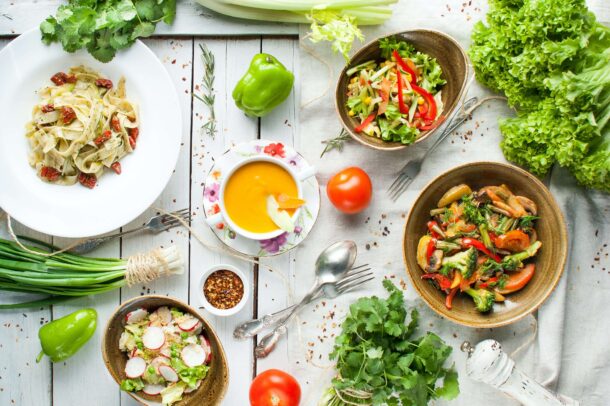Written by Anna Richardson, MPH RD
Many people choose to be vegetarian for lots of reasons including health, animal welfare, environmental concerns, or religious customs. Whether you eat meat and other animal products is a personal decision. Your renal dietitian will be happy to discuss your diet with you, whether you eat a vegetarian diet or a non-vegetarian diet, to help you feel your best.
Let’s break down some terms:
Vegetarian: A diet without meat or poultry. Some people who follow a vegetarian diet eat fish, and most also eat dairy products and eggs.
Flexitarian: A semi-vegetarian diet – may include occasional meat but mostly vegetarian
Plant-based: A style of eating that typically focuses on vegetables, fruits, whole grains, and legumes (beans, lentils and nuts), with lower intake of other foods (dairy, animal products)
Vegan: A diet that contains no animal products – no meat, poultry, fish, dairy, eggs
A vegetarian, vegan, or plant based diet is not automatically “healthy” – for example, many cookies, candies, fried foods and highly processed foods are vegetarian or vegan! However, with some planning, many people with CKD can enjoy a balanced vegetarian diet.
In the past few years, there has been more research showing the benefits of following a vegetarian diet for people with CKD. Studies show that vegetarian diets can help protect kidney function and delay dialysis. Vegetarian diets are also associated with improved blood pressure, improved acid-base balance and less inflammation in people with CKD compared to non-vegetarians with CKD.
How do I get enough protein?
In some stages of kidney disease, it is recommended to eat less protein, and on dialysis, more protein is needed. Speak with your doctor and nutritionist about your personal needs. If you have CKD and are not on dialysis, you may need to limit your protein intake. Eating a vegetarian diet may make this a bit easier, as plant-based protein foods have less protein per serving than meats and also come with lots of fibre and vitamins.
If you are on dialysis and are recommended to eat a higher protein diet, it is important to have a protein source for mostmeals. In a vegetarian diet, this could be cow’s milk or soymilk, cheese read our blog post on how to enjoy cheese on a CKD diet, beans or lentils, nuts or nut butter, whole grains such as quinoa, oats or whole wheat pasta, tofu, or a protein powder supplement. It may be easier than you think!
What about potassium and phosphorus?
Of course, many people with CKD are mindful of their dietary potassium and phosphorus intake – so how does being vegetarian work with these restrictions?
Phosphorus
For many years, people with CKD were told to focus on animal proteins and to avoid plant-based proteins like beans and lentils. Newer research has found that the phosphorus from plant proteins is less absorbed than from animals, so plant-based proteins are an excellent choice for many! This includes beans, lentils, nuts, whole grains, and soy products like tofu, soy milk and tempeh.
Check out this KCK blog post for more information about phosphorus absorption.
Potassium
You may be aware that many plant foods are high in potassium – but did you know that meat, poultry and fish are also quite high in potassium? Due to the high fibre content of beans, lentils, nuts and whole grains, they help limit how much potassium is absorbed from foods in the gut and help keep our bowels moving regularly to help eliminate toxins from our bodies. Many people with CKD can safely include these foods in their diet.
Certainly, there are some very high potassium plant foods that many people will need to limit– including potatoes (unless double boiled: read our blog on how to lower potassium in potatoes), avocados, dried fruits, and tomato sauce, but thankfully there are still many lower potassium fruits and vegetables to enjoy, including berries, apples, bell peppers and cucumbers, among many others.
Soaking and cooking plant-based foods can also reduce the amount of potassium in them. For example, soaking lentils overnight for 12 hours and soaking leafy greens for 2 hours and then discarding the water can remove a significant amount of potassium. Another win for plant-based foods!
To learn more about reducing potassium in beans and lentils, check this blog post.
Tips for eating vegetarian with CKD
Cook at home more often – this way, you can help limit excess salt and avoid potassium and phosphate additives
Soak your beans, lentils and vegetables to reduce potassium
Get a variety of foods! Experiment in the kitchen with different types of beans, grains and veggies.
Speak with your renal dietitian to discuss your diet.
Looking for more info about vegetarian diets and CKD? Check out our other blog posts:
- Soy vs Animal Protein
- Steps to a more Kidney-Friendly Diet
- Kidney Beans and Plant Based Protein
- More Meatless Mondays
- Plant Based Diets
- Plant Based Protiens
Looking for vegetarian kidney-friendly recipes?
